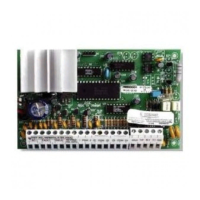4
Keybus Terminals – AUX+, AUX-, YEL, GRN
The Keybus is used by the panel to communicate with mod-
ules and vice versa. Each module has four Keybus terminals
that must be connected to the four Keybus terminals on the
panel. For more information, see section 2.3 “Keybus Opera-
tion and Wiring”.
Programmable Output Terminals – PGM1 and
PGM2
Each PGM output is designed so that when activated by the
panel, the terminal will switch to ground.
PGM1 can sink up to 300mA of
current. Connect the positive
side of the LED or buzzer to
AUX+, the negative side to
PGM1. If more than 300 mA of
current are required, a relay
must be used. Please study
PGM wiring in the accompany-
ing diagram.
PGM2 operates similarly to
PGM1. However, PGM2 can only
sink up to 50mA of current. For a
list of the programmable output
options, see section 5.11 “PGM
Output Options”.
Zone Input Terminals – Z1 to Z4
Each detection device must be connected to a zone on the
control panel. We suggest that one detection device be con-
nected to each zone; wiring multiple detection devices to a
single zone, however, is possible. For zone wiring specifics,
please see section 2.8 “Zone Wiring”.
Telephone Connection Terminals – TIP, RING, T-1,
R-1
If a telephone line is required for central station communica-
tion or downloading, connect an RJ-31X telephone jack in
the following manner:
NOTE: For proper operation, no other telephone equipment
should be connected between the control panel and the tele-
phone company facilities. Do not connect the alarm panel
communicator to telephone lines intended for use with a fax
machine. These lines may incorporate a voice filter which dis-
connects the line if anything other than fax signals are
detected, resulting in incomplete transmissions.
2.3 Keybus Operation and Wiring
The Keybus is used by the panel to communicate with all con-
nected modules and vice versa. The red (AUX+) and black
(AUX-) terminals are used to provide power, while the yellow
(YEL) and green (GRN) terminals are clock and data respec-
tively.
NOTE: The four Keybus terminals of the panel must be con-
nected to the four Keybus terminals or wires of all modules.
The following restrictions apply to Keybus wiring:
• Keybus should be run in minimum 22 gauge quad
(0.5mm); two pair twist is preferred.
• The modules should be home-run to the panel but can
be connected in series or T-tapped.
• Any module can be connected anywhere along the Key-
bus. You do not need to run a separate Keybus wire for
keypads, etc.
• No module can be more than 1,000'/305m (in wire
length) from the panel.
• Shielded wire should not be used.
Example of Keybus Wiring
NOTE:
Module (A) is correctly
wired within 1,000'/305m
of wire from the panel.
Module (B) is correctly
wired within 1,000'/305m
of wire from the panel.
Module (C) is NOT wired
correctly as it is further than 1,000'/305m from the panel, in
wire distance.
2.4 Current Ratings – Modules and
Accessories
In order for the PC585 system to operate properly, the power
output capabilities of the main control and the expansion
devices must not be exceeded. Use the data presented
below to ensure that no part of the system is overloaded and
cannot function properly.
PC585 (12 V
DC)
AUX+:.........550mA: Subtract the listed rating for each key-
pad, expansion module and accessory con-
nected to AUX+ or Keybus.
BELL:..........700mA continuous rating; 3.0A short term. Avail-
able only with standby battery connected.
PC585 Device Ratings (at 12 V
DC)
• LCD5500Z Keypad: 85mA
• PC1555RKZ Keypad: 85mA
• PC5508Z Keypad: 85mA
• PC5400 Serial Module: 65mA
• PC5132 Wireless Receiver: 125mA
Other Devices
Please read the manufacturer’s literature carefully to deter-
mine the maximum current requirements for each device—
during activation or alarm—and include the proper values for
loading calculations. Connected devices must not exceed
system capabilities during any possible operational mode.
2.5 Keypad Assignment
There are eight available slots for keypads. LED keypads by
default are always assigned to slot 1. LCD5500Z keypads
are always assigned to slot 8. You will need to assign each
keypad to its own slot (1 to 8). Keypad assignment is
required, as it tells the panel which slots are occupied. The
panel can then generate a fault when a keypad supervisory
is not present.
NOTE: One LCD keypad must be assigned to slot 8 in order
to upload keypad programming using DLS-1 software.

